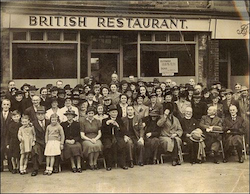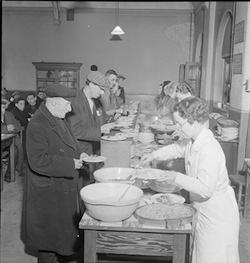The cost of living crisis requires bold action by the state to prevent severe hunger, says CHRIS OLEWICZ. Perhaps today’s ideological government could learn from the ‘national kitchen’ and ‘British restaurant’ initiatives of war-time Britain.
The cost of living crisis this winter will require bold action, not just by the government but also from local authorities. With the Conservative government hamstrung by an ideological vice that severely limits the kind of solutions it will contemplate, it might be up to local authorities to bridge the gap.
Of course, this could not have come at a worse time for councils, who are hamstrung by more than a decade’s worth of cuts and depleted cash reserves. In some cities, austerity is undermining efforts to provide ‘warm banks’ to those who are unable to sufficiently heat their homes.
 It doesn’t have to be like this, however. History provides us with more than one example of state-led, council-controlled initiatives that could be part of the answer. ‘National kitchens’, later known as ‘British restaurants’, were first developed by the Ministry of Food in 1917 and persisted in some cities into the 1950s and ’60s.
It doesn’t have to be like this, however. History provides us with more than one example of state-led, council-controlled initiatives that could be part of the answer. ‘National kitchens’, later known as ‘British restaurants’, were first developed by the Ministry of Food in 1917 and persisted in some cities into the 1950s and ’60s.
Initially, the partly state-funded kitchens offered food to ‘ordinary people’ – usually soup, meat and vegetables – for as little as £1. Many were short-lived due to opposition from private restaurant owners, and all were closed following the end of the war.
But they made a more formal return during the Second World War when they were christened British restaurants by Winston Churchill (who hated the alternative name of community feeding centres). These were primarily focused on providing food for families who had been bombed out of their homes, had run out of ration coupons, or otherwise needed help. Private restaurants did continue and were not subject to rationing.
Later, some were converted into ‘civic restaurants’ under the 1947 Civic Restaurants Act, and put under local authority control. The Labour Party of the day viewed them as a valuable initiative, providing nourishing food for all.
Bryce Evans of Liverpool University has recently rescued the British restaurants from obscurity. In his book, Feeding the People in Wartime Britain, and subsequent articles, he has called for their return to combat the cost of living crisis.
The original idea, he claims, was proposed by R Hippisley Cox, HJ Bradley and Eustace Miles, who were appointed by the Ministry of Food to design the first kitchen in Westminster. In Public Kitchens: Their Organisation and Importance, the trio stated:
“Probably at some future time it will be difficult to believe that each household in the country did its own separate marketing, buying small amounts of food from retail dealers a hundred per cent above cost price, that every hundred houses in a street each had its own fire for cooking, and that at least a hundred human beings were engaging in serving meals that could have been better prepared by half a dozen trained assistants.
“The cry of the day is that we should save, and this means that we should not only save in the sense of not using, but that we should also save in the sense of using wisely. Cooking in large quantities, as in a Public Kitchen, in addition to saving human effort, economises gas, coal or electricity, and appreciably prevents waste.”
Food for the millions
There is an earlier example we can learn from, too. In the 1880s, Catherine Booth, co-founder of the Salvation Army with her husband William, organised ‘food for the million’ shops where poor people could buy cheap food at Christmas. A retired German military officer known as Captain MP Wolff adopted the same name as part of his project to distribute quality food to the working classes in a self-supporting way.
 He first set out his ideas in a lecture to National Health Society in 1883, noting that the benefits of the industrial revolution had made available “a good many luxuries” at a low price, such that producing the same articles at home from raw materials did not make sense.
He first set out his ideas in a lecture to National Health Society in 1883, noting that the benefits of the industrial revolution had made available “a good many luxuries” at a low price, such that producing the same articles at home from raw materials did not make sense.
“Nowadays the kitchens of the poor and poorer middle classes have become a rather costly institution,” he said. It was time to break with the “untimely prejudice” that the kitchen was the centre of female domestic bliss.
“What our times … really and most urgently require is the concentration … of large capital, skilfully devised cooking machines, and well premeditated distribution of labour for producing great quantities of tasty and nourishing food daily, which necessarily can be so good and so cheap as to remove one of the greatest grievances in the life of, not only some thousands of single men and women, but of many hundred thousands of families. Never will modern industry have fulfilled a higher and nobler task!”
The chief benefits, Wolff claimed, would be the time and energy saved by removing the trouble of cooking; and the guarantee of food to the public made from the very best, unadulterated ingredients. The benefits to those who were willing to invest in the idea and become shareholders in the kitchens was a small and reliable profit.
For those who used the restaurants, he hoped to take away the drudgery of cooking and preparing meals. For those who were destitute, feeding them was second best only to providing them with work. The kitchens would provide “the working population with food without hurting their independence and self-esteem”, he said.
“Ten years hence, in every large town of the civilised world, one will look upon the idea of daily cookery done in the home kitchens … as an odd, untimely and absurd occupation.”
Bold action
Wolff later expounded on his idea in greater detail in his book, Food for the Million, and many of his words ring true 140 years later:
“About a year ago, the columns of our leading papers overflowed with bitter complaints on the part of the public that the price of meat never declined, in spite of the yearly increasing imports from abroad; that fish was to be had cheaper, when ordered and sent from the London fish-markets, sixty to one hundred miles by rail and road, than at the very spot where it was taken from the sea or river; and that the loaf had not increased in size, although wheat was cheaper than it had been for many a year.”
He went on to note that “the ‘middle classes’ … quickly and resolutely adopted the only proper means of self-protection left to them, by starting co-operative stores, which have answered the purpose very well, and have equally satisfied both, customers, and shareholders.
“But very little has been done for the labouring from hand-to-mouth-living classes, who yet are counted by millions,” he added.
By the 1880s the co-operative movement had largely moved away from the idea of alleviating poverty towards providing independence for the skilled working classes, who would grow the movement for the next 70 years. Yet, an undertaking like Wolff’s food for the million restaurant could work on co-operative lines today, with some form of community management, and with profits reinvested or returned to members.
Whether it’s called a British restaurant, a national kitchen or food for a million, a modern-day project of this kind could provide quality food for all at a reasonable price. What’s clear is that without bold action of some sort, many families across the country this Christmas will find themselves caught in a vice, just not one of their own making.
—-
Christopher Olewicz is an historian and director of Principle 5: Yorkshire Co-operative Resource Centre based in Sheffield.
See also: ‘Cost of Living Crisis: Why We Need a New Wave of Co-operatives’ by Chris Olewicz.


